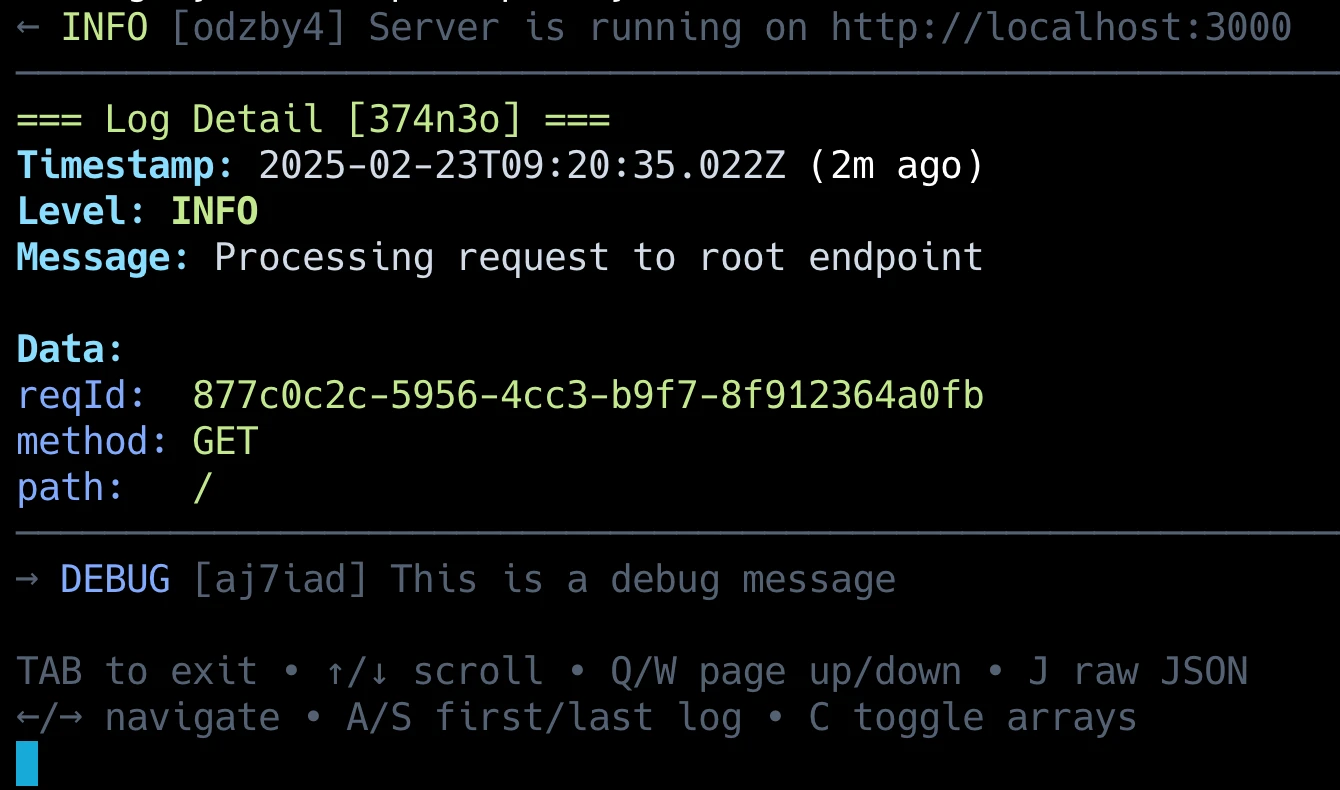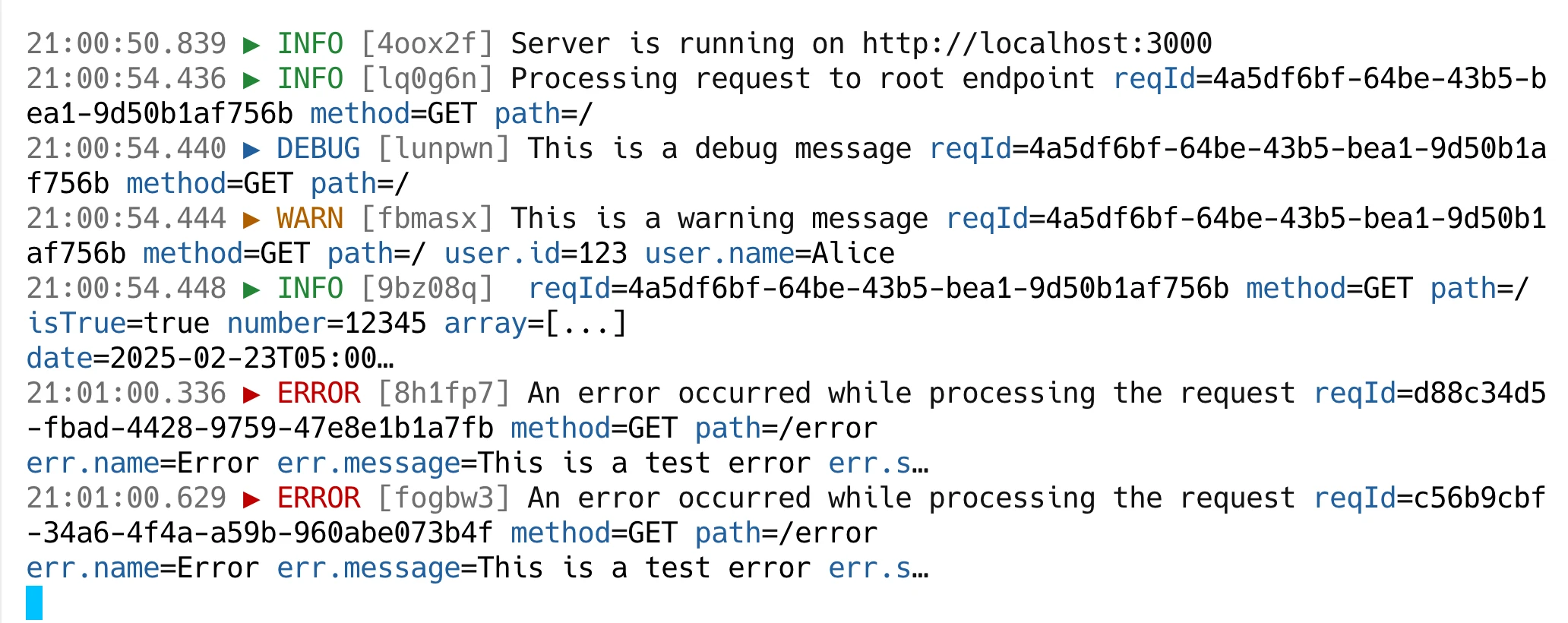Pretty Terminal Transport Server
The Pretty Terminal Transport provides interactivity and pretty printing for your logs in the terminal. It has interactive browsing, text search, detailed viewing for large logs, and themes.
Using Next.js or LogLayer in a browser?
This transport has dependencies that are not supported in Next.js or a browser. Use the Simple Pretty Terminal instead.
Running multiple applications concurrently?
This transport has interactive features that are designed for a single app. If you are running multiple apps concurrently in the same terminal, then it is recommended you use the the Simple Pretty Terminal instead.
Features
- 🔍 Interactive Selection Mode - Browse and inspect logs in a full-screen interactive view
- 📝 Detailed Log Inspection - Examine individual log entries with formatted data and context
- 🔎 Search/Filter Functionality - Find specific logs with powerful filtering capabilities
- 💅 JSON Pretty Printing - Beautifully formatted structured data with syntax highlighting
- 🎭 Configurable Themes - Choose from pre-built themes or customize your own colors
Installation
Compatbility Note
Pretty Terminal has only been tested in MacOS with the native Terminal app and Warp. It may not work as expected in other terminal emulators or operating systems.
npm install loglayer @loglayer/transport-pretty-terminal serialize-errorpnpm add loglayer @loglayer/transport-pretty-terminal serialize-erroryarn add loglayer @loglayer/transport-pretty-terminal serialize-errorBasic Usage
Development Only
Pretty Terminal is designed to work in a terminal only for local development. It should not be used for production environments.
It is recommended that you disable other transports when using Pretty Terminal to avoid duplicate log output.
import { LogLayer, ConsoleTransport } from 'loglayer';
import { getPrettyTerminal } from '@loglayer/transport-pretty-terminal';
import { serializeError } from "serialize-error";
// Create LogLayer instance with the transport
const log = new LogLayer({
errorSerializer: serializeError,
transport: [
new ConsoleTransport({
// Example of how to enable a transport for non-development environments
enabled: process.env.NODE_ENV !== 'development',
}),
getPrettyTerminal({
// Only enable Pretty Terminal in development
enabled: process.env.NODE_ENV === 'development',
})
],
});
// Start logging!
log.withMetadata({ foo: 'bar' }).info('Hello from Pretty Terminal!');Single-Instance Only
Because Pretty Terminal is an interactive transport, it may not work well if you run multiple applications in the same terminal window that share the same output stream.
If you need to run multiple applications that use Pretty Terminal in the same terminal window, you can:
- Use the
disableInteractiveModeoption to disable keyboard input and navigation features - Keep interactive mode enabled in only one application and disable it in others
- Use the Simple Pretty Terminal instead.
The transport is designed to work as a single interactive instance. getPrettyTerminal() can be safely used multiple times in the same application as it uses the same transport reference.
Performance Note
Logs are stored using an in-memory SQLite database by default. For long-running applications or large log volumes, consider using a persistent storage file using the logFile option to avoid out of memory issues.
Keyboard Controls
The Pretty Terminal Transport provides an interactive interface with three main modes:
Simple View (Default)

The default view shows real-time log output with the following controls:
P: Toggle pause/resume of log outputC: Cycle through view modes (full → truncated → condensed)↑/↓: Enter selection mode
When paused, new logs are buffered and a counter shows how many logs are waiting. Resuming will display all buffered logs.
The view has three modes:
- Full View (default): Shows all information with complete data structures (no truncation)
- Truncated View: Shows complete log information including timestamp, ID, level, message, with data structures truncated based on
maxInlineDepthandmaxInlineLengthsettings - Condensed View: Shows only the timestamp, log level and message for a cleaner output (no data shown)
When entering selection mode while paused:
- Only logs that were visible before pause are shown initially
- Buffered logs from pause are tracked as new logs
- The notification shows how many new logs are available
- Pressing ↓ at the bottom will reveal new logs
Selection Mode

An interactive mode for browsing and filtering logs:
↑/↓: Navigate through logsENTER: View detailed log information (preserves current filter)TAB: Return to simple view- Type to filter logs (searches through all log content)
BACKSPACE: Edit/clear filter text
When filtering is active:
- Only matching logs are displayed
- The filter persists when entering detail view
- Navigation (↑/↓) only moves through filtered results
- New logs that match the filter are automatically included
Each log entry in selection mode shows:
- Timestamp and log ID
- Log level with color coding
- Complete message
- Full structured data inline (like simple view's full mode)
- Selected entry is highlighted with
►
Detail View

A full-screen view showing comprehensive log information:
↑/↓: Scroll through log content line by lineQ/W: Page up/down through content←/→: Navigate to previous/next log entry (respects active filter)A/S: Jump to first/last log entryC: Toggle array collapse in JSON dataJ: Toggle raw JSON view (for easy copying)TAB: Return to selection view (or return to detail view from JSON view)
Features in Detail View:
- Shows full timestamp and log level
- Displays complete structured data with syntax highlighting
- Shows context (previous and next log entries)
- Shows active filter in header when filtering is enabled
- Auto-updates when viewing latest log (respects current filter)
- Pretty-prints JSON data with color coding
- Collapsible arrays for better readability
- Raw JSON view for easy copying
Configuration
The Pretty Terminal Transport can be customized with various options:
import { getPrettyTerminal, moonlight } from '@loglayer/transport-pretty-terminal';
const transport = getPrettyTerminal({
// Maximum depth for inline data display in truncated mode
maxInlineDepth: 4,
// Maximum length for inline data in truncated mode
maxInlineLength: 120,
// Custom theme configuration (default is moonlight)
theme: moonlight,
// Optional path to SQLite file for persistent storage
logFile: 'path/to/logs.sqlite',
// Enable/disable the transport (defaults to true)
enabled: process.env.NODE_ENV === 'development',
// Disable interactive mode for multi-app terminal output (defaults to false)
disableInteractiveMode: false,
});Configuration Options
Required Parameters
None - all parameters are optional.
Optional Parameters
| Name | Type | Default | Description |
|---|---|---|---|
maxInlineDepth | number | 4 | Maximum depth for displaying nested data inline. Only applies in truncated view mode. Selection mode and detail view always show full depth |
maxInlineLength | number | 120 | Maximum length for inline data before truncating. Only applies in truncated view mode. Selection mode and detail view always show full content |
theme | PrettyTerminalTheme | moonlight | Theme configuration for colors and styling |
logFile | string | :memory: | Path to SQLite file for persistent storage. Relative paths are resolved from the current working directory. If not provided, uses in-memory database |
enabled | boolean | true | Whether the transport is enabled. If false, all operations will no-op |
disableInteractiveMode | boolean | false | Whether to disable interactive mode (keyboard input and navigation). Useful when multiple applications need to print to the same terminal |
Security Note
If using the logFile option, be aware that:
- All logs will be stored in the specified SQLite database file.
- The file will be purged of any existing data when the transport initializes
- Relative paths (e.g., "logs/app.db") are resolved from the current working directory
- It is recommended to add the
logFilepath to your.gitignorefile to avoid committing sensitive log data - Do not use the same logfile path in another application (as in two separate applications running the transport against the same file) to avoid data corruption.
If you do have sensitive data that shouldn't be logged in general, use the Redaction Plugin to filter out sensitive information before logging.
Themes
The transport comes with several built-in themes to match your terminal style:
Moonlight Theme (Default)
A dark theme with cool blue tones, perfect for night-time coding sessions and modern IDEs.

import { getPrettyTerminal, moonlight } from '@loglayer/transport-pretty-terminal';
const transport = getPrettyTerminal({
theme: moonlight,
});Sunlight Theme
A light theme with warm tones, ideal for daytime use, high-glare environments, and printed documentation.

import { getPrettyTerminal, sunlight } from '@loglayer/transport-pretty-terminal';
const transport = getPrettyTerminal({
theme: sunlight,
});Neon Theme
A vibrant, cyberpunk-inspired theme with electric colors and high contrast, perfect for modern tech-focused applications.

import { getPrettyTerminal, neon } from '@loglayer/transport-pretty-terminal';
const transport = getPrettyTerminal({
theme: neon,
});Nature Theme
A light theme with organic, earthy colors inspired by forest landscapes. Great for nature-inspired interfaces and applications focusing on readability.

import { getPrettyTerminal, nature } from '@loglayer/transport-pretty-terminal';
const transport = getPrettyTerminal({
theme: nature,
});Pastel Theme
A soft, calming theme with gentle colors inspired by watercolor paintings. Perfect for long coding sessions and reduced visual stress.

import { getPrettyTerminal, pastel } from '@loglayer/transport-pretty-terminal';
const transport = getPrettyTerminal({
theme: pastel,
});Custom Themes
You can create your own theme by implementing the PrettyTerminalTheme interface, which uses chalk for color styling:
import { getPrettyTerminal, chalk } from '@loglayer/transport-pretty-terminal';
const myCustomTheme = {
// Configuration for the default log view shown in real-time
simpleView: {
// Color configuration for different log levels
colors: {
trace: chalk.gray, // Style for trace level logs
debug: chalk.blue, // Style for debug level logs
info: chalk.green, // Style for info level logs
warn: chalk.yellow, // Style for warning level logs
error: chalk.red, // Style for error level logs
fatal: chalk.bgRed.white, // Style for fatal level logs - background red with white text
},
logIdColor: chalk.dim, // Style for the unique log identifier
dataValueColor: chalk.white, // Style for the actual values in structured data
dataKeyColor: chalk.dim, // Style for the keys/property names in structured data
selectorColor: chalk.cyan, // Style for the selection indicator (►) in selection mode
},
detailedView: {
// Inherits all options from simpleView, plus additional detailed view options
colors: {
trace: chalk.gray,
debug: chalk.blue,
info: chalk.green,
warn: chalk.yellow,
error: chalk.red,
fatal: chalk.bgRed.white,
},
logIdColor: chalk.dim,
dataValueColor: chalk.white,
dataKeyColor: chalk.dim,
// Additional detailed view specific options
headerColor: chalk.bold.cyan, // Style for section headers
labelColor: chalk.bold, // Style for field labels (e.g., "Timestamp:", "Level:")
separatorColor: chalk.dim, // Style for visual separators
// Configuration for JSON pretty printing
jsonColors: {
keysColor: chalk.dim, // Style for JSON property names
dashColor: chalk.dim, // Style for array item dashes
numberColor: chalk.yellow, // Style for numeric values
stringColor: chalk.green, // Style for string values
multilineStringColor: chalk.green, // Style for multiline strings
positiveNumberColor: chalk.yellow, // Style for positive numbers
negativeNumberColor: chalk.red, // Style for negative numbers
booleanColor: chalk.cyan, // Style for boolean values
nullUndefinedColor: chalk.gray, // Style for null/undefined values
dateColor: chalk.magenta, // Style for date values
},
},
};
const transport = getPrettyTerminal({
theme: myCustomTheme,
});
